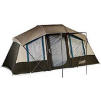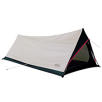|
| | Thinking of camping? Like to buy a tent, but don't know where to start? Here are a few tips:
We know: 6 Tips Before You Buy a Tent
1. TYPES OF TENTS
There are basically three types of camping tents: | | | | | Dome tents come in half (tube-style) and full dome shapes and tend to be roomy and stable. They can be a good choice for back packers, depending on weight and size. | |  | | | | | | Cabin tents are shaped more like a house, with walls and a roof. They are the roomiest of the three styles and a good choice if you only have to move them from the car to the camping spot nearby. They tend to be heavier than the other two styles and not good in windy weather. | |  | | | | | | A-Frame tents are shaped like a triangle, most suitable for one or two people and are easy to put up and take down. They are often portable because they usually aren't self-standing. That means they often require fixed points such as trees for setting up and suitable soil for ground stakes. They don't maximize space and aren't very good in bad weather. | |  |
2. SIZE and WEIGHT
Think about the number of people using the tent and how you will use the tent. Generally, tents fall into two categories: group tents for family-type outings, and hiking tents that can be carried long distances.
You can also find tents that with serve both these functions-midsize but light weight and portable.
- Family tents - for groups of 4 or more people, you want something roomy and sturdy. This usually means a large dome-style tent that you can haul around in the family car.
- Hiking or canoe tent - for this purpose you want something smaller, light in weight, that is easy to carry and store, such as a 2-person tube or A frame tent. Think about whether you will use the tent just for sleeping, or whether you want a style that is suitable for sitting up.
3. EASE OF ASSEMBLY
Consider how difficult the tent will be to put up each time. Check out the directions to see how complicated assembly is. Also look at how much gear there is to lug around and put together.
Free standing tents, for instance, usually require more poles. They can be used almost anywhere, but are heavier and bulkier.
A tent that is not free standing will have fewer poles to lug around, but think about where you'll be using it. Generally, you'll need trees or something to anchor the tent to, and the soil must be suitable for stakes (not too rocky or sandy).
4. MATERIALS
There are 3-season tents and 4-season tents. If you're going to be camping out in extreme conditions, buy something made to keep you warm and dry. Look for material that is moisture proof and as that doesn't rip easily (rip stop material).
5. FEATURES
- Doors - Make sure they're large enough. Also, look for tents with two doors, or with doors and windows, so that you can get cross ventilation.
- Floors - Look to see if the floor extends at least 6" up the side of the tent wall, to help ensure the tent won't leak.
- Set Up - You can make life easier by choosing a tent that has color-coded clips, poles and tabs.
- Glow in the Dark - Look for zippers or other tent materials that glow in the dark so you can have an easier time setting up at night.
- Sealed Seams - Tents with tape along the seams tent to be more water resistant.
- Storage Space - Look for tent models that offer you special storage spaces, if that's something you need.
6. SAMPLE PRICES
Prices for tents vary widely, depending on quality, size and style. Here’s a glimpse of the range in prices.
| Sleeps | Size (sq. ft. ) & Type | Quality | Price | | 2-person | 32 sq. ft. A-frame | low quality | Approx. $35 | | 2-person | 63 sq. ft. half-dome | low quality | Approx. $50 | | 1-person | 15.5 sq. ft. half-dome | high quality | Approx. $130 | | 2-person | 32 sq .ft. dome tent | high quality | Approx. $175 | | 6-person | 108 sq. ft. dome tent | low quality | Approx. $100 | | 5-person | 91 sq. ft. dome tent | high quality | Approx. $400 | | 8-person | 140 sq. ft. cabin tent | low quality | Approx. $140 |
|
